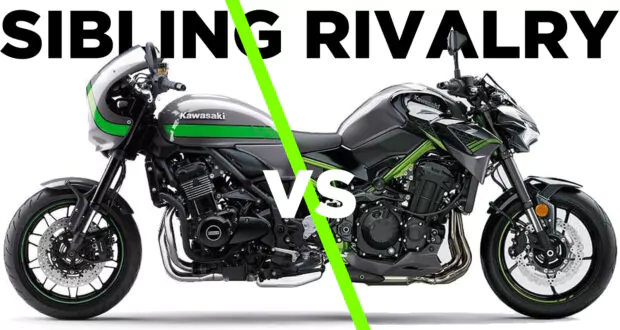If you’re in the market for a middleweight motorcycle, the Kawasaki Z900RS and Kawasaki Z900 models are both worth considering. What do you get for the $1,500 increase in MSRP from the Z900 to the Z900RS? Quite a lot actually!
In this article, we’ll be taking a detailed look at the differences between the Kawasaki Z900RS and Kawasaki Z900, including powertrain, suspension, technological rider aides, brakes, exhaust, and more. Whether you’re a retro enthusiast or a modern rider, this article will help you make an informed decision on which model is right for you.
Aesthetics
The most noticeable difference is aesthetics. The Kawasaki Z900 is noticeably much more modern and aggressive in design. The Z900RS on the other hand offers more traditional, universal Japanese motorcycle (UJM) aesthetics. The Z900RS is inspired by the 1972 Kawasaki Z1 900 and many of the motorcycle’s lines are a throwback to that legendary motorcycle from the 1970s.
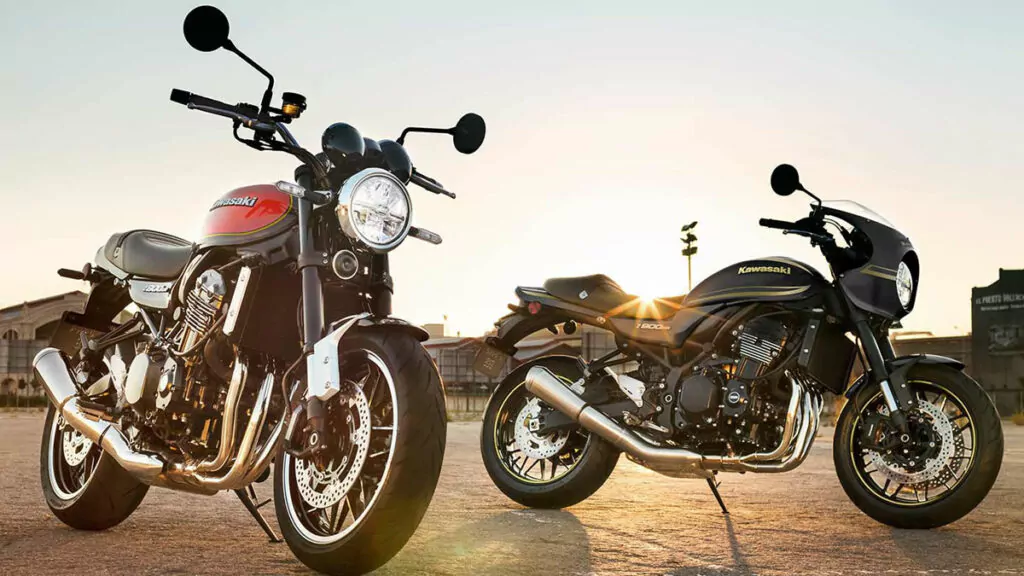
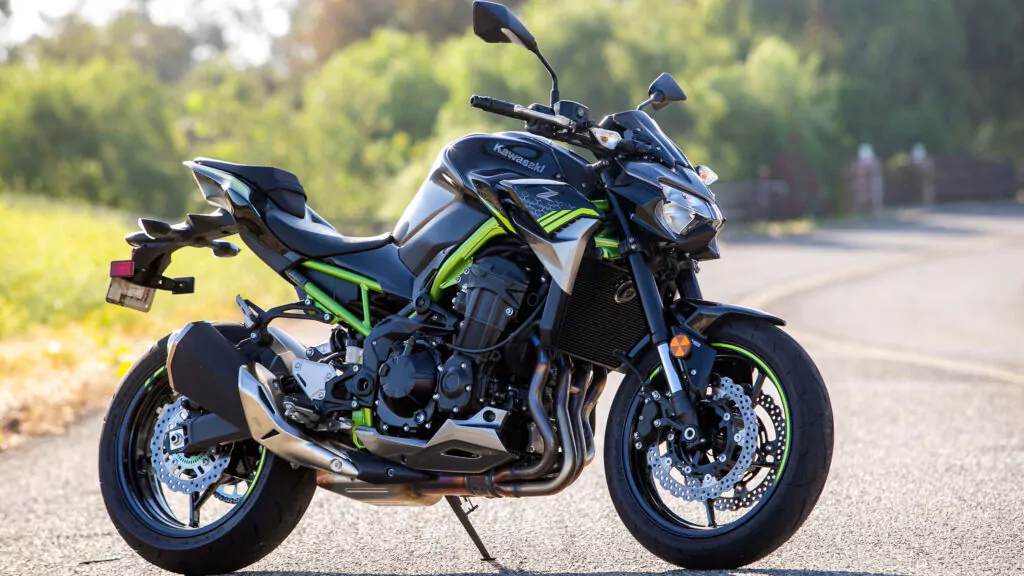
Frame and geometry
In order to nail the retro vibe, the Z900RS required a new, different frame from the Kawasaki Z900. The frame on the Z900 has a high rear frame, in line with that motorcycle’s modern, sportier style. The Z900RS rear frame is much lower and more flat, in other to get the lines needed for that classic 1970s and 1980s UJM look.
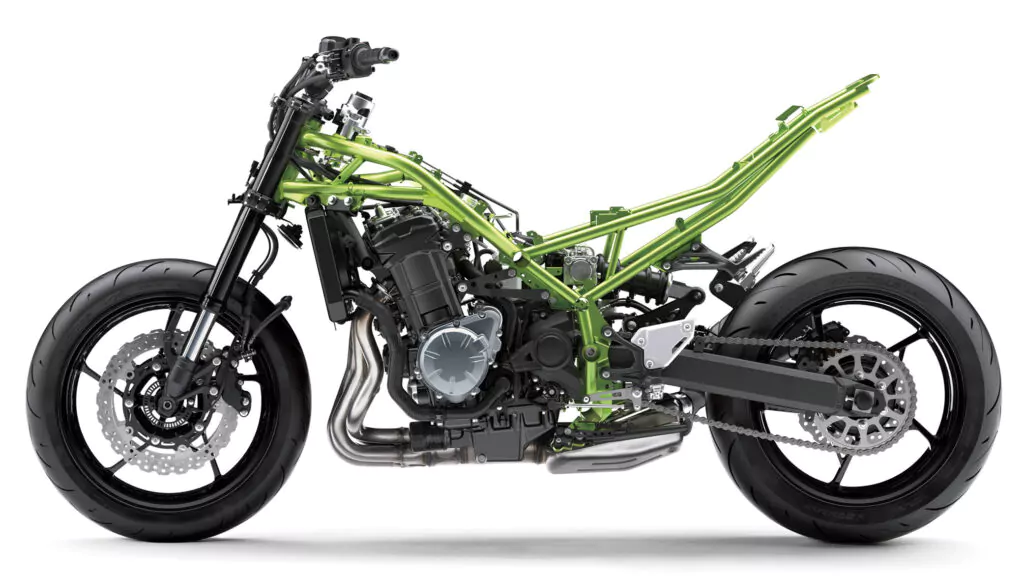
The frame changes have implications on the overall dimensions that will impact everything from ergonomics to riding performance. The Z900RS is a touch longer, but not by a noticeable amount.
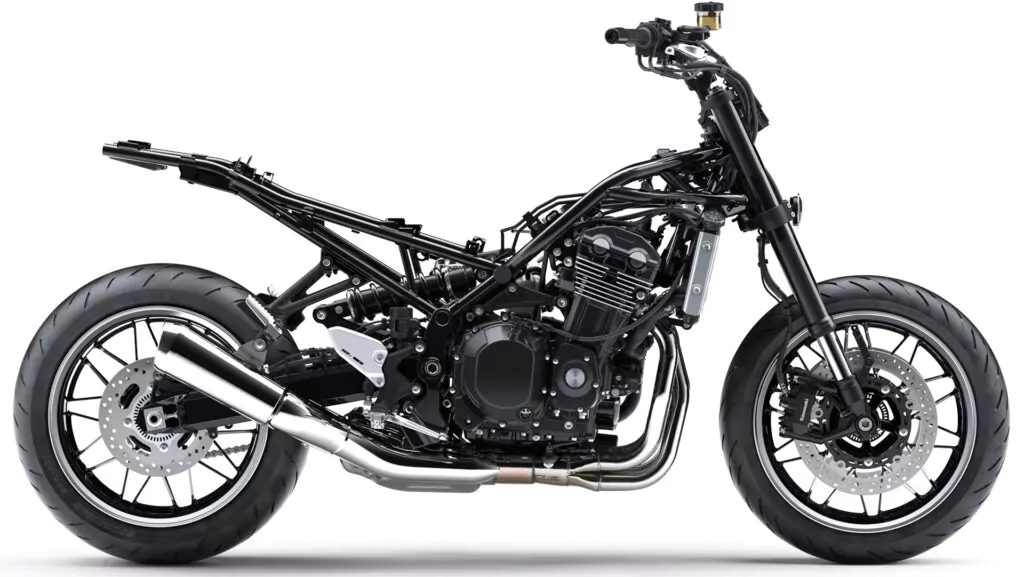
The rake, trail, and steering angle of the Z900 and Z900RS are similar but different. There are also differences in wheelbase, seat height, and handlebar position effecting the rider triangle so the best way to figure out which motorcycle’s handling suits you best is just to jump on and take both for a test ride.
| Z900 | Z900RS | |
| Dimensions (L x W x H) |
2,070 x 825 x 1,080 mm (81.5 x 32.5 x 42.5 in) |
2,100 x 865 x 1,150 mm (82.7 x 34.1 x 45.3 in) |
| Wheelbase | 1,455 mm (57.3 in) | 1,470 mm (57.9 in) |
| Road Clearance | 145 mm (5.7 in) | 130 mm (5.1 in) |
| Seat Height | 820 mm (32.3 in) | 800 mm (31.5 in) |
| Wet Weight | 212 kg (467 lb) | 214 kg (472 lb) |
| Rake / Trail | 24.9° / 110 mm | 25.0° / 98 mm |
| Steering Angle | 33° | 35° |
Ergonomics
The ergonomics of seat height and the overall rider triangle play a big part towards your comfort on and handling any motorcycle. The rider triangle, also called the ergonomics triangle, describes the relationship between the rider’s feet, seat, and hands.
In the example below we’ve compared the 2017 Kawasaki Z900 vs the 2018 Z900RS, and how a 5’11” motorcycle rider with a 32″ inseam would look on both motorcycles. The Z900 is much more leaned forward, crouched, and aggressive. The Z900RS is much more upright and relaxed in riding position. Both sets of ergonomics will have their trade offs of pros and cons.
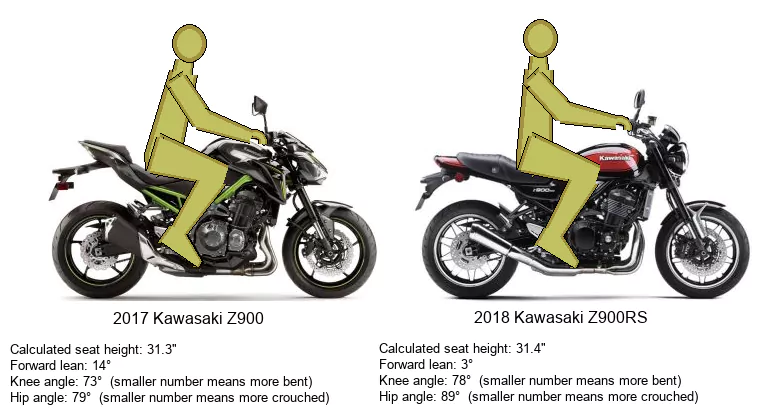
The Z900’s ergonomics may be a good start for sportier rides. The Z900RS should be better for all-day comfort, though if you plan on riding all day you may want a wind screen to keep that wind off of your chest, it will be very exposed.
It’s also important to note that seat height may change over the years. The 2023 Z900 now has a 32.3″ seat height, up 1″ from the 2017. The 2023 Z900RS seat has remained unchanged at 31.5″ from it’s debut in 2018 until now.
Powertrain
The next difference between the Z900RS and the Z900 is in the power train of each motorcycle’s engine. The Kawasaki Z900RS is tuned for low-end mid-range torque. In other words, Kawasaki have taken the motor’s available power, and moved it further down the rev range, so that your powerband will be more in the range that motorcyclists will the majority of their riding in, and not just when riding aggressively.
To do this, Kawasaki has made a few small tweaks to the Z900 motor including lowering the compression, and changing some of the transmission gearing ratios. First gear is now a bit lower on the Z900RS than on the Z900 to allow for quicker acceleration from a stop. Sixth gear is a bit taller to give you a bit more of a relaxed cruising gear compared to the Z900.
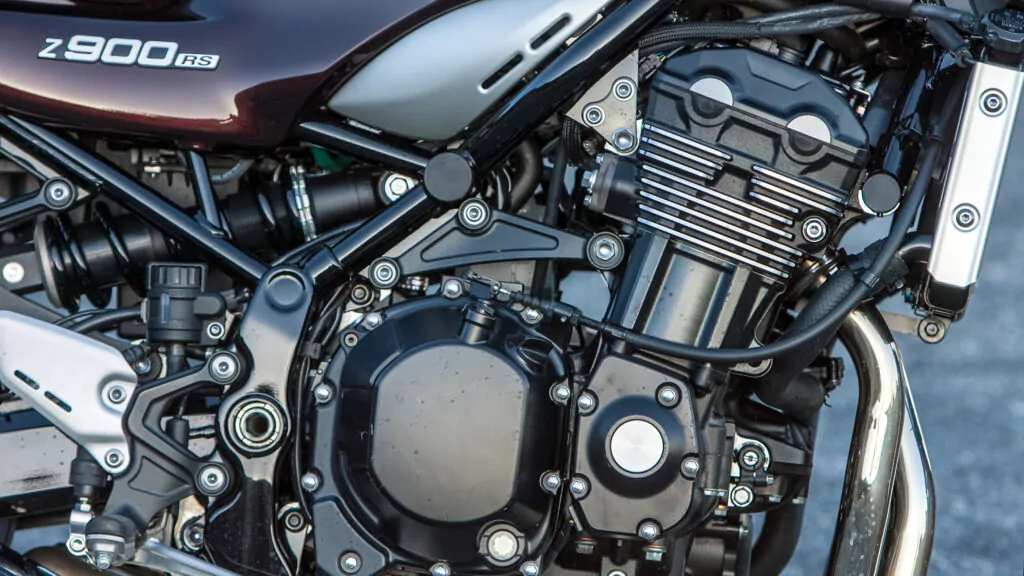
Traction control
Since it launched in 2017, the Kawasaki Z900RS came standard with two-level traction control. The Z900 wouldn’t get traction control until 2020.
Suspension
The Z900RS and Z900 shared suspension similarities in the past, specifically in the motorcycle’s rear shock, however the Z900RS has always had an advantage.
In the front, Z900RS and Z900 use a ø41mm inverted fork with rebound damping, spring preload adjustability, with 4.7” (120mm) of travel. However, the Z900RS also features compression damping, the Z900 does not.
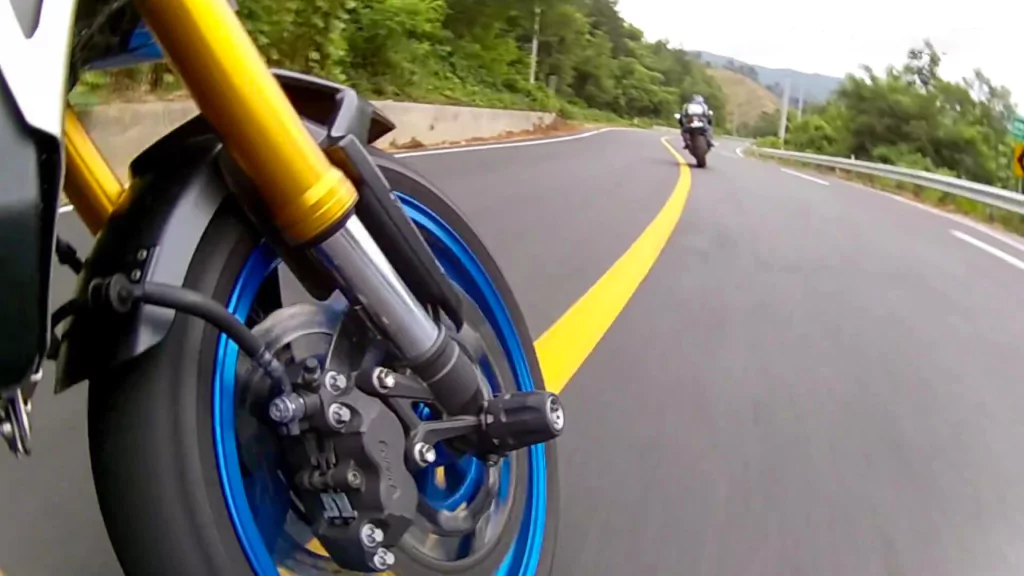
The rear suspension will vary by year model, but for 2023, both the Kawasaki Z900RS and Z900 have a horizontal back-link with rebound damping and spring load adjustability for 5.5” (140 mm) of travel. However, the rear shock on the Z900RS is gas-charged, while the Z900 still is not.
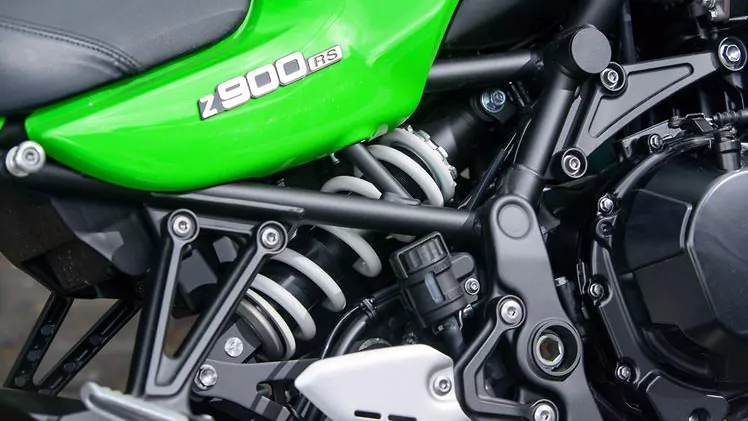
Gas-charged shocks have several advantages including improved stability and control and less likelihood of bottoming out or losing their damping capacity under heavy loads or during aggressive riding. A gas-charged shock will give you more consistence performance over time, throughout the lifespan of the shock. You’ll also see less likelihood of the shock overheating as the gas helps to dissipate the heat. Finally gas-powered rear shocks’ damping can more easily be fine-tuned to their needs and riding style.
Brakes
A difference between the Z900RS and Z900 that’s more easy to see, is in the motorcycle brakes. Both the Z900RS and Z900 use dual semi-floating ø300 mm petal discs, but the disks on the Z900RS look more traditional, whereas those on the Z900 look a bit more aggressive.
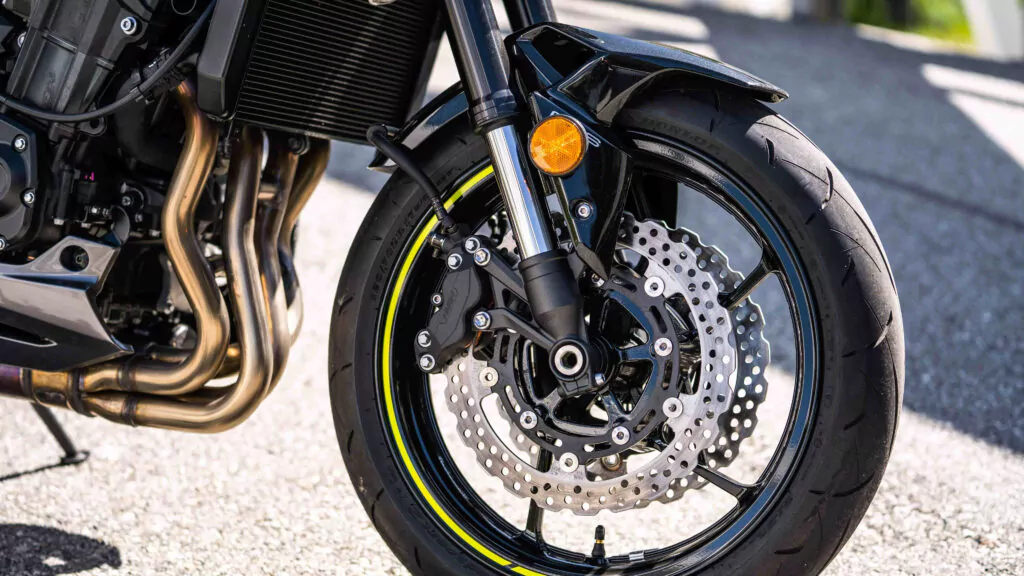
Sure, the rotors look differently, but more importantly, the calipers are mounted differently, and this makes a big difference. The Z900RS uses radial mounted brake calipers which offers a number of advantages.
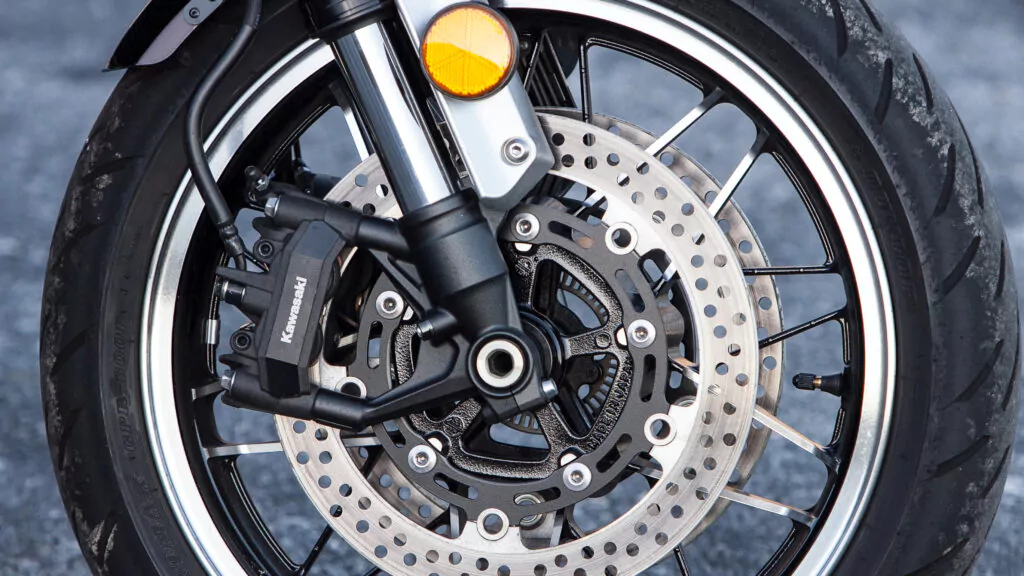
Radial mount brake calipers offer increased braking power thanks to a more rigid and stable mounting system that helps transfer braking forces more effectively from the brake pads to the rotors, leading to better stopping power and shorter stopping distances. The increase in rigidity also helps to dissipate heat better, reducing the likelihood of brake fade from overheating. Radial mount calipers also give more consistent and precise brake feel which helps the rider modulate braking force with greater accuracy and confidence.
For either motorcycle, I’d recommend upgrading from rubber to steel brake lines.
Exhaust
Kawasaki has made some exhaust changes from the Z900 exhaust to the Z900RS including moving it a bit lower and further back to avoid the issue of a rider’s foot hitting the exhaust pipe. This has been solved on the Z900RS, but is still the same on the Z900.
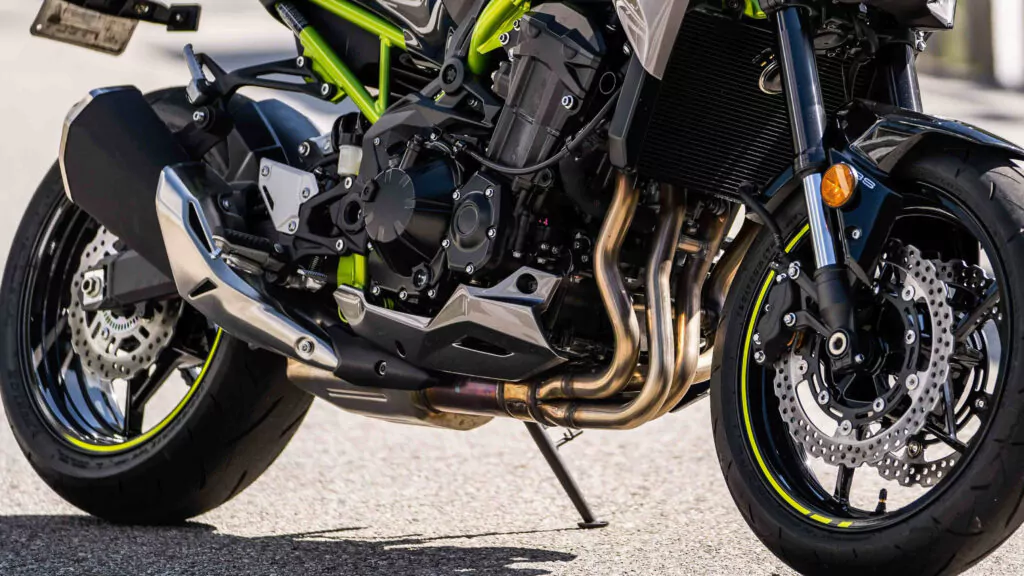
Also, the header pipes on the Z900RS are dual-tubed, meaning there is a tube within a tube. This creates a gap between the exhaust pipes which helps to minimize exhaust discoloration on the Z900RS, but the Z900 does not have this same attention to detail.
Gauges
The Z900RS uses analog gauges, in line with it’s retro throwback appeal. The Z900 uses digital gauges, which is in line with it’s more modern and aggressive styling.
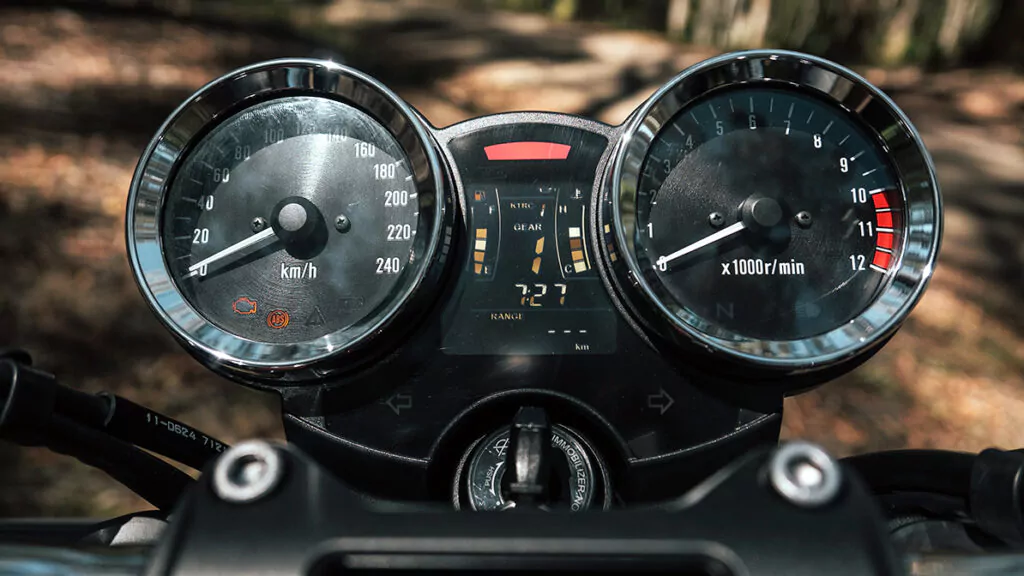
Headlight
While the choice of gauges are very in line with the aesthetic differences of the Z900RS and the Z900, Kawasaki’s choice of lighting is more in line with the differences in price-point between the two motorcycles. The Z900RS comes standard with an LED headlight fitted to a retro looking circular headlight assembly, whereas the Z900 has more aggressive angular headlights but only comes equipped with traditional halogen headlights.
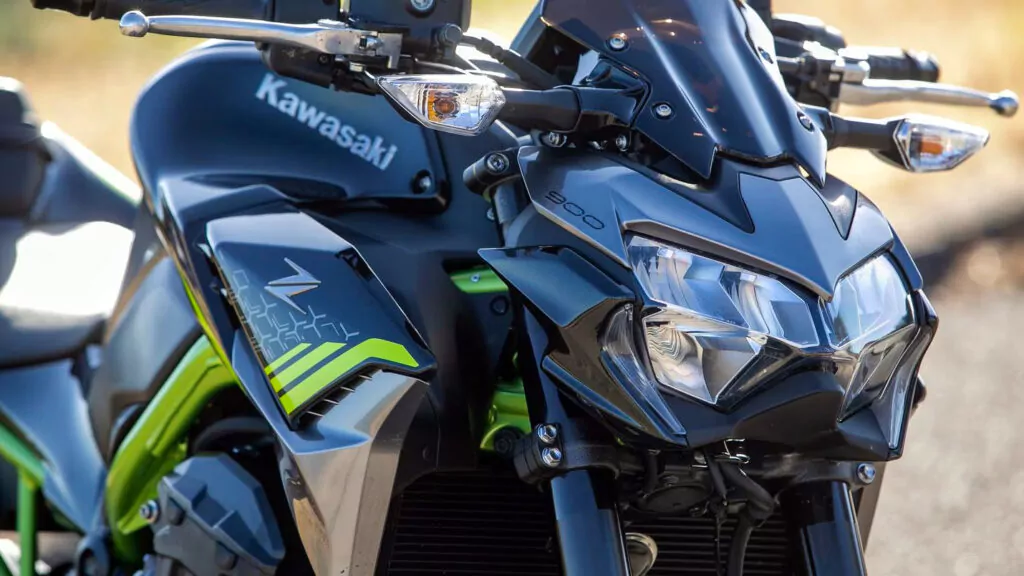
Conclusion
The Z900 is a modern and aggressive motorcycle, while the Z900RS is a throwback to the 1970s and 1980s Universal Japanese Motorcycle (UJM) style. Depending on your preference, one model may be more suitable than the other, but there is definitely a lot more than aesthetic differences between these two motorcycles.
The $1,500 increase in MSRP from the Kawasaki Z900 to the Z900RS offers a surprising number of enhancements that may be worth the investment for the right rider. From powertrain, suspension, electronic rider aides, brakes, suspension and exhausts, the differences between the two models are significant. You could buy a Z900 and spend $1,500 on modifications, but it still wouldn’t be anywhere near as good as a Z900RS.
In conclusion, the Kawasaki Z900 and Kawasaki Z900RS both offer a unique and thrilling ride for those in the market for a middleweight motorcycle. Only you can decide which one is right for you, but for me, I am getting a Z900RS. Watch for my ownership review coming soon!
 YouMotorcycle Motorcycle Blog – Motorcycle Lifestyle Blog, MotoVlog, Motorcycle Reviews, News, & How-Tos
YouMotorcycle Motorcycle Blog – Motorcycle Lifestyle Blog, MotoVlog, Motorcycle Reviews, News, & How-Tos
